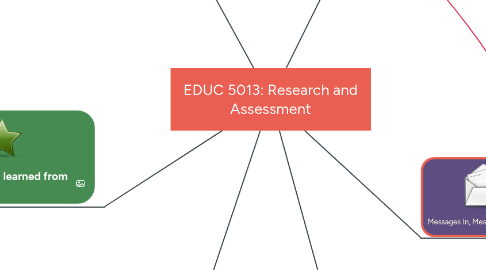
1. Connecting High and Low
1.1. Research
1.1.1. Oriented toward solving problems
1.1.2. Deliberate, methodical and accurate
1.1.3. Rigorous in method, observation and analysis
1.1.4. Can be broadly categorized into Academic (Theoretical) and Applied (Practical) research
1.1.5. Done by experts (e.g. Us)
1.2. Professional
1.2.1. Evaluation Process in Your Classroom
1.2.1.1. Design & Selection:Choosing Types of Evidence of Learning
1.2.1.2. Professional Judgment:Interpreting Evidence of Learning
1.2.1.3. Marking:Valuing Evidence of Learning
1.2.1.4. Feedback:Reporting on Evidence of Learning
1.3. Practice
2. 3 BIG IDEAS you learned from this course
2.1. What is the point of assessment?
2.1.1. To form instruction
2.1.2. Tell the student where they’re are
2.1.3. See the progress in a student
2.1.4. For student’s to be able to self-assess
2.1.5. Tells the teacher if we’re teaching them well
2.1.6. The primary purpose of assessment and evaluation is to improve student learning
2.1.7. Everything we do should help students improve
2.2. Teachers can inspire and inquire
2.2.1. Keeping research alive in youth
2.2.2. Research can be done within the classroom as we teach, observe and interact with our students
2.3. Teaching strategies are constantly being researched and developed in order for our students to reach their full potential.
3. Actions to implement in my practice
3.1. Connecting global competencies to our classroom activates
3.1.1. Critical thinking and problem solving
3.1.1.1. Example : Present students with case studies
3.1.1.2. Teach student on how to be critically literate
3.1.1.3. Encourage them to question things
3.1.2. Inovation, creativity and entrepreneurship
3.1.2.1. Example: Shark tank pitch
3.1.3. Learning to learn/ Self-aware and self directed learning
3.1.3.1. Example: Creating portfolios
3.1.3.2. Blogging
3.1.3.3. Using mind mapping or infographics
3.1.4. Collaboration
3.1.4.1. Example: Jigsaw activity
3.1.5. Communication
3.1.5.1. Example: Class debate
3.1.6. Global citizenship
3.1.6.1. Example: Blanket exercise (teaching my students about Aboriginal history)
3.2. Gradual Release of Responsibility
3.2.1. Teaching method that encourages collaboration and an active learning environment. Teaching moves from the teacher carrying all of the responsibility to situations where the students are given responsibility.
3.2.2. It is important that we show our students how to work autonomously in order to prepare them for the future.
3.3. Giving effective feedbackk
3.3.1. My goal is to give my students feedback that is goal-oriented, tangible and transparent, actionable, user-friendly, timely, ongoing and consistent.
3.3.2. I want my school to become better everyday and one way of doing that is by giving them feedback that they understand and are able to self-evaluate
4. Research and Assessment as Human Activities
4.1. The primary purpose of assessment and evaluation is to improve student learning
4.2. Growing Success: Seven Fundamental Principles of Assessment
4.2.1. Fair, transparent and equitable for all
4.2.2. Support all students
4.2.3. Relate to the curriculum and student interests, needs and experiences
4.2.4. Communicated clearly and regularly to students and parents
4.2.5. Multiple opportunities , ongoing , carried in nature
4.2.6. Ongoing descriptive feedback that is clear, specific meaningful and timely
4.2.7. Develop students’ self-assessment skills
5. Messages In, Messages Out
5.1. Points of Data Collection/Feedback
5.1.1. Input
5.1.1.1. Before teaching and learning
5.1.2. Process
5.1.2.1. During teaching and learning
5.1.3. Satisafaction
5.1.3.1. Throughout teaching and learning
5.1.4. Output
5.1.4.1. After teaching and learning
5.2. 6 Types of Assessment
5.2.1. Diagnostic
5.2.2. Norm-referenced
5.2.3. Formative
5.2.4. Criterion-Referenced
5.2.5. Summative
5.2.6. Periodic
5.3. Action Research Cycle
5.4. What factors affect our assessment choices?
5.4.1. Course and grade level
5.4.2. Subject Area
5.4.3. Delivery method
5.4.4. Philosophy of learning
5.4.5. Class makeup
5.4.6. Student needs/interests
5.4.7. Teacher practice
5.4.8. Available resources

